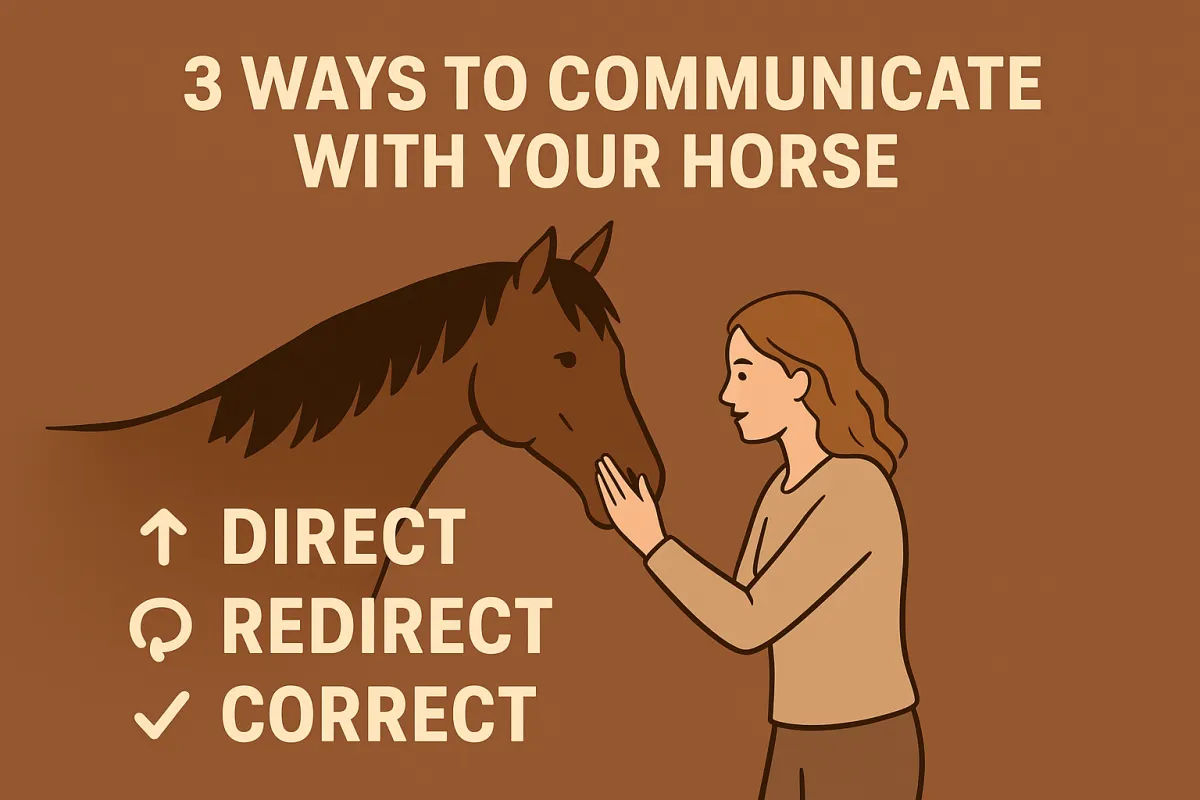
🧩 Three Ways to Communicate With Your Horse — and One That’s a No-Go
When we work with horses, everything we do communicates something — whether we mean to or not. Our horses are constantly reading our energy, our intent, and our clarity. The question isn’t if we’re communicating… It’s how.
In horsemanship, there are three effective ways we can communicate with our horse: Direct, Redirect, or Correct.
And there’s one approach that’s an absolute no-go: Aggression.
Let’s unpack what each of these looks like — and how understanding them can transform the way you and your horse connect.
1️⃣ Direct: Giving Clear Instructions
A direct cue is simply giving your horse a clear instruction — a direction with intent. It’s when we break things down small enough that our horse can understand what we’re asking.
If your horse doesn’t respond as expected, it’s usually not defiance — it’s confusion.
In my experience, a horse doesn’t understand for one of three reasons:
The ask was too big, or too many cues were blended together.
The timing of the release wasn’t clear enough to mark the right effort.
The horse simply doesn’t yet understand the request.
When this happens, it’s not time to get frustrated — it’s time to simplify.
Dissect the task into smaller pieces until your horse can succeed. Then stack those pieces together to build understanding.
Think of the direct cue as you saying, “Here’s what I’d like you to do.”
2️⃣ Redirect: Continuing the Conversation
Redirect is one of the most misunderstood — yet most powerful — forms of communication.
Redirect doesn’t mean the horse is wrong. It means you’re continuing the conversation. It’s the back and forth between horse and human — the part where learning and connection truly happen.
Maybe your horse didn’t quite follow your first cue. Rather than labeling it as failure, see it as feedback. A redirect simply means you’re helping guide your horse back toward the original intention.
For example, if you’re asking your horse to load into a trailer and they stop to look — that’s not wrong! That’s curiosity or fear. If they turn away, you gently redirect them back to facing the trailer. You might have to do this dozens (or even hundreds) of times — but each redirect is part of the conversation that builds understanding and confidence.
The magic of horsemanship lives in the redirect.
3️⃣ Correct: Used Rarely and Without Emotion
A correction should be rare — and never come from anger or frustration.
It’s used only when a horse knows what’s being asked but chooses to respond with aggressive or unsafe behavior.
For example, if a horse moves into your space in a way that’s dangerous — say, running over you — it’s critical to move them away firmly and immediately. This isn’t done out of meanness, but for safety and clarity.
The correction must be clear, fair, and absent of emotion. Think of it as strong leadership — not punishment.
🚫 The No-Go: Aggression
Aggression is not communication — it’s the absence of it.
Aggression shows up when there’s no clarity, no intent, and too much energy driven by emotion — frustration, anger, or fear.
It’s never productive. It breaks trust, confuses your horse, and damages the very relationship you’re trying to build.
Horses don’t need domination. They need direction, redirection, and the occasional fair correction — always with calm intent and purpose.
💬 The Conversation That Builds Connection
When you view communication with your horse as a dialogue — not a demand — everything changes.
The direct sets the intention.
The redirect keeps the conversation going.
The correction, when necessary, reinforces boundaries.
And aggression? That never has a seat at the table.
The most beautiful partnerships are built not from control, but from conversation — one cue, one redirect, and one moment of understanding at a time.
🐴 Keep the Conversation Going — Join the Miles Made Elevate Membership
If this message spoke to you, imagine how much more you and your horse could grow with guided support and a like-minded community.
Become part of the Miles Made Elevate Membership — your next step toward clarity, confidence, and connection.
Discover Elevate Membership Here.
